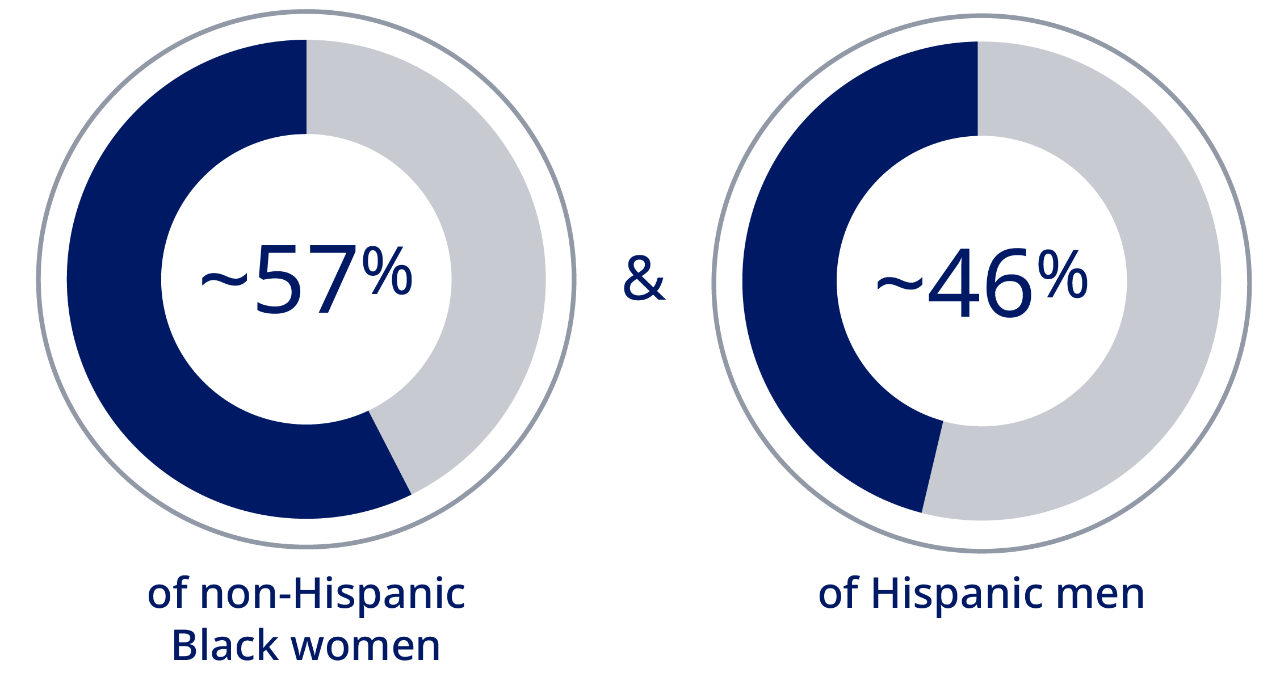OBESITY AND CULTURE
Understanding your patients’ cultural nuances can help you create a weight-management plan that fits their lifestyles
Nearly 40.3% of the total US adult population has obesity.* However, the prevalence of obesity for some minority populations is even higher.1,2†
*Based on NHANES 2021-2023 data.
†Based on NHANES 2017-2018 data.
Hispanic and non-Hispanic Black adults have the highest prevalence rates of overweight or obesity2

Age-adjusted prevalence of obesity among adults aged 20 years and over, United States, 2017-2018.2

have obesity compared with ~42% of non-Hispanic White adults2
Age-adjusted percentage of people 20 years of age and older who had overweight or obesity, 2017-2018 (body mass index [BMI] of 30 kg/m2 or greater).2

In 31 states, the prevalence of obesity among non-Hispanic Black adults is 35% or higher. In only 1 state is the prevalence of obesity among non-Hispanic White adults that high.3
Prevalence of self-reported obesity among US adults, 2017.
These data show that health inequities disproportionately affect certain racial and ethnic communities.
The influence of culture
Understanding your patients’ cultures is important. It may help you to better connect with them and create a weight- management plan that your patients can adhere to.4 Below are examples of some cultural factors you may want to consider when having a discussion with your patients about their weight-management plan and goals.

Food culture
Food culture comprises the attitudes, beliefs, and traditions about food and eating and can impact eating behaviors and food preferences.5

Body image
Feelings about body image can vary from one racial or ethnic group to another. Gender and race may have a role in body image and dissatisfaction.6

Gender and food preferences
Hispanic/Latino men may be conditioned to eat more meat and fats, whereas Hispanic/Latina women may be more likely to eat more fruits and vegetables based on patterns established by previous generations.7
Culture Matters in the Obesity Conversation
Dr. Sandra Sobel describes how culture influences choices and understanding that can help you relate better to patients with obesity.

Video length: 1:30
1. Emmerich SD, Fryar CD, Stierman B, Ogden CL. Obesity and severe obesity prevalence in adults: United States, August 2021-August 2023. NCHS Data Brief. 2024;(506):1-10.
2. Hales CM, Carroll MD, Fryar CD, Ogden CL. Prevalence of obesity and severe obesity among adults: United States, 2017-2018. NCHS Data Brief. 2020;(360):1-8.
3. Petersen R, Pan L, Blanck HM. Racial and ethnic disparities in adult obesity in the United States: CDC’s tracking to inform state and local action. Prev Chronic Dis. 2019;16:E46.
4. Paez KA, Allen JK, Beach MC, Carson KA, Cooper LA. Physician cultural competence and patient ratings of the patient‑physician relationship. J Gen Intern Med. 2009;24(4):495-498.
5. Dao MC, Thiron S, Messer E, et al. Cultural influences on the regulation of energy intake and obesity: a qualitative study comparing food customs and attitudes to eating in adults from France and the United States. Nutrients. 2020;13(1):63.
6. Chithambo TP, Huey SJ. Black/white differences in perceived weight and attractiveness among overweight women. J Obes. 2013;2013:320326.
7. Overcash F, Reicks M. Diet quality and eating practices among Hispanic/Latino men and women: NHANES 2011-2016. Int J Environ Res Pub Health. 2021;18(3):1302.
8. Simmonds M, Llewellyn A, Owen CG, Woolacott N. Predicting adult obesity from childhood obesity: a systematic review and meta-analysis. Obes Rev. 2016;17(2):95-107.
9. Woo JG, Zhang N, Fenchel M, et al. Prediction of adult class II/III obesity from childhood BMI: the i3C consortium. Int J Obes (Lond). 2020;44(5):1164-1172.




